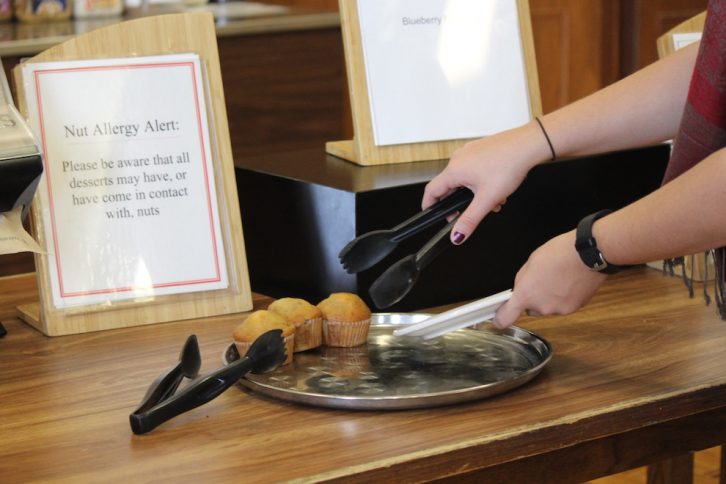Health
King’s dining hall takes steps to accommodate allergies
'I don't know if I can go to school'

caption
King's meal hall places signage around the cafeteria to remind students of food allergies. (Photo by Samantha Calio)
caption
In the University of King’s College dining hall, all nut products are kept on a separate table.Imagine walking into a restaurant, but being afraid to eat. Everyone around you is enjoying their meal while you watch, because for you, eating may lead to a hospital visit – or worse.
Now imagine going to that restaurant every day during the school year. For university residence students who live with food allergies or disorders, this is a reality.
“I was so concerned. It stressed me out so bad that I was like, ‘I don’t know if I can go to school’,” says Grace Girvan, 18, a first-year student at the University of King’s College.
Girvan has lived with celiac disease since she was seven. Her symptoms include painful stomach aches and feeling as if she has the flu.
It’s a digestive disorder which causes damage to the small intestine when the person ingests gluten, a protein found in wheat, rye and barley. According to Beyond Celiac, a foundation focusing on widespread celiac education, about one per cent of the population has the disease.
Celine Beland, general manager for Sodexo, the food service provider at King’s, says the school’s dining hall takes precautions to ensure that students with food allergies feel safe and accommodated.
“It is easier for us here because we are a small university at King’s, right? So after two weeks all my staff know each student and all the ones on the meal plan with severe allergies,” she says.
[idealimageslider id=”15372″]
She says the kitchen uses separate pans to cook kosher meals, labels gluten free foods and keeps all nut product on one separate table near the back of the hall. Beland also personally meets each student who has a food allergy to make sure she understands their restrictions and to make them “feel more comfortable, like home.”
For Grace, seeing a small “GF” (for gluten free) next to meals on the menu meant not having to worry.
“They had gluten-free pasta already made …. It was really nice and convenient.”
Alex Rose, a one-year Bachelor of Journalism student at the university, remembers feeling safe eating in the meal hall while in his first year.
“I knew to stay away from the back counter, where the nuts were.”
Rose has an allergy to tree nuts, including pecans, cashews, walnuts and pistachios but not peanuts. About 2.4 per cent of the population has an allergy to tree nuts.
“My tongue gets itchy … I can taste and feel it on my tongue. Then I get congested, or my throat closes up or my stomach gets upset. Each reaction is a bit different.”
Although Rose never experienced a reaction while eating at the King’s meal hall, he did have a false alarm after eating a Nanaimo bar. He used his EpiPen, a single dose injector which treats allergic reactions, and went to the hospital to be sure.

caption
Rose demonstrates how he would use his EpiPen.In the 12 years that Beland has been working at the King’s dining hall she has only witnessed one student have a reaction. The student ate ice cream containing nuts, but luckily had an EpiPen.
“Please carry your EpiPen with you all the time,” she tells students with known allergies.
Girvan says that the cautiousness of the meal hall allows her to get more out of campus life, a factor she believes not many people would be aware of.
“It’s more than just an allergy, it’s a social thing,” she says.
“I’d like people to try and be more aware, like when (you’re going) out to a restaurant they’re like, ‘Hey let’s go to this place.’ The person with the food allergy is thinking, ‘Will I be able to eat there?’.”
Food Allergy Canada states on its website that about 2.5 million Canadians report having at least one food allergy.

